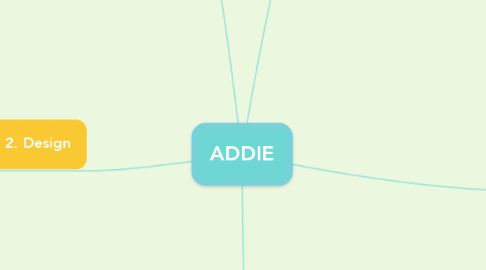
1. The analysis phase of the model will provide a high level overview of what the program is, what it will look like, who will benefit from it and why it is required. This sets up the basis for the entire program and is essential
2. 2. Design
2.1. Create Learning Objectives
2.1.1. Based on what the learners need to learn
2.2. High level design of course content
2.2.1. Flow of the content, the information contained within the course. Accurate and correct
2.3. Mode of delivery and requirements
2.3.1. Decide on mode of delivery, what does this require?
2.4. Cost, effort, time
2.4.1. How many people are needed? How much will it cost? How much time do we need to spend on it?
2.5. Testing and Assessment
2.5.1. Decide on the methods of assessment
3. 1. Analysis
3.1. Identify Target Audience
3.1.1. Knowledge level of subject
3.1.2. Previous Knowledge
3.1.3. Gaps in Knowledge
3.1.4. Characteristics
3.2. Identify the audience
3.3. Identify Program Objectives to fulfil training need
3.4. Create training plan including theme, subject, planning, timeline, method of deliver
3.5. Create training Content outline
3.6. Justification
3.7. Feedback and evaluation
4. The design phase provides for a high level overview of the entire course including the content summary and flow of the course. It should also include information on cost analysis and time for development.
5. 4. Implementation
5.1. Preparation to rollout training
5.1.1. Facilitator training if required to cover content, learning outcomes, assessment methods
5.1.2. Testing phase prior to 'golive'
5.2. Administration support
5.2.1. Online, this may include sending invites, publication, pulling reports on attendance from LMS or sending and collating feedback
5.2.2. Face-to-face, this may include scheduling, invites, reporting, sending and collating feedback
5.3. Feedback and evaluation
5.3.1. This will include at facilitator training, any changes will have to be made now. At tester level before Golive and from the Training Coordinator for any changes to implementation from an administration perspective.
6. 5. Evaluation
6.1. Primer and 30 or 60 day Post Surveys
6.1.1. These can be useful to gain data on the success of a course. On improvements, efficiency, knowledge gained by the learner
6.2. Feedback survey
6.2.1. This is the feedback survey that immediately follows the end of the session, to obtain data on the course content, facilitator knowledge, engagement, timings etc
6.3. Feedback from stakeholders
6.3.1. This includes any touchpoint throughout the entire process, looking for areas of improvement. Even though we obtain feedback throughout the process its always good to go back
6.4. Testing and Assessment
6.4.1. This includes the testing and assessment of the learner during and after the course to understand how much knowledge has been absorbed during the session
7. 3. Development
7.1. Development of course content using chosen delivery method
7.1.1. Produce the content
7.2. Design course
7.2.1. Based on theme, colour, images, layout, flow and structure. The course needs to be engaging and meangingful
7.3. Feedback and evaluation
7.3.1. Throughout the development phase seek feedback and arrange set testing stages to ensure the flow of the course, the accuracy of the information and user engagement

